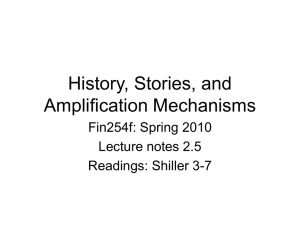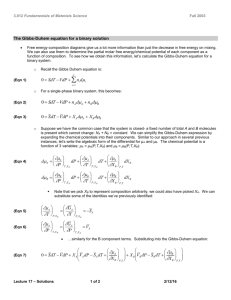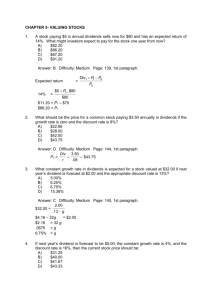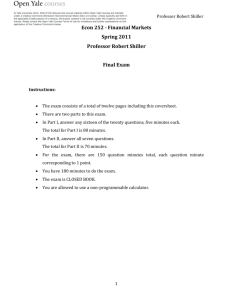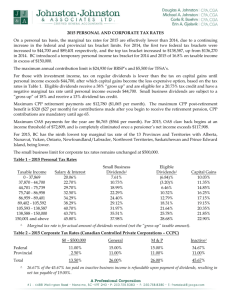do stock prices move too much to be justified by
advertisement
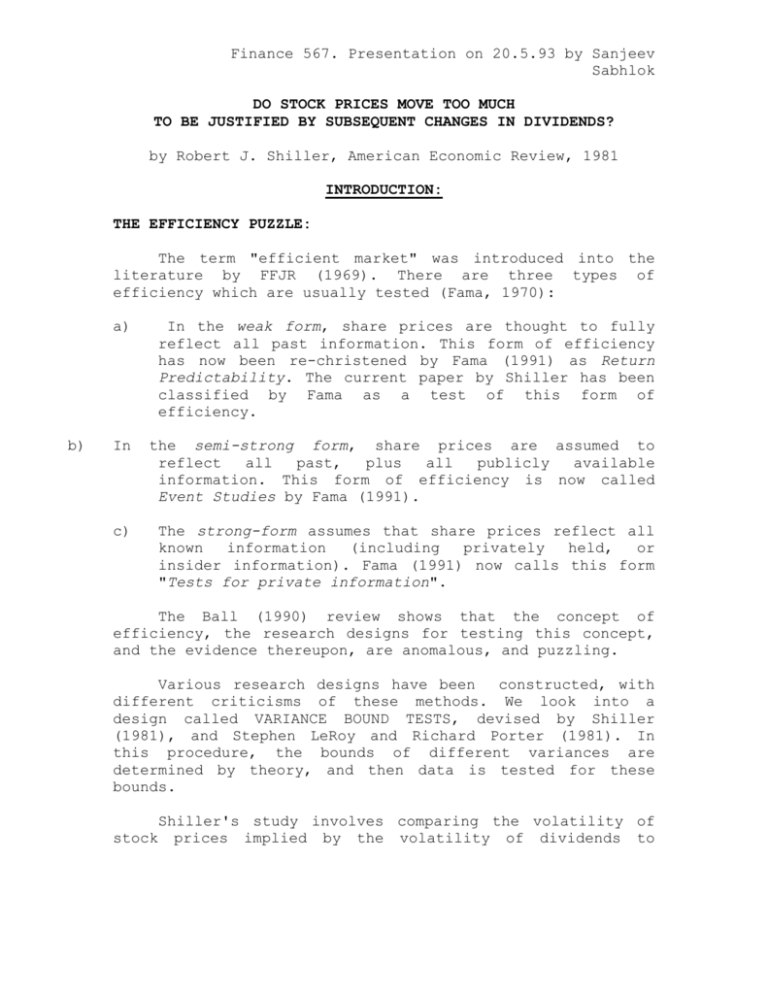
Finance 567. Presentation on 20.5.93 by Sanjeev Sabhlok DO STOCK PRICES MOVE TOO MUCH TO BE JUSTIFIED BY SUBSEQUENT CHANGES IN DIVIDENDS? by Robert J. Shiller, American Economic Review, 1981 INTRODUCTION: THE EFFICIENCY PUZZLE: The term "efficient market" was introduced into the literature by FFJR (1969). There are three types of efficiency which are usually tested (Fama, 1970): b) a) In the weak form, share prices are thought to fully reflect all past information. This form of efficiency has now been re-christened by Fama (1991) as Return Predictability. The current paper by Shiller has been classified by Fama as a test of this form of efficiency. In the semi-strong form, share prices are assumed to reflect all past, plus all publicly available information. This form of efficiency is now called Event Studies by Fama (1991). c) The strong-form assumes that share prices reflect all known information (including privately held, or insider information). Fama (1991) now calls this form "Tests for private information". The Ball (1990) review shows that the concept of efficiency, the research designs for testing this concept, and the evidence thereupon, are anomalous, and puzzling. Various research designs have been constructed, with different criticisms of these methods. We look into a design called VARIANCE BOUND TESTS, devised by Shiller (1981), and Stephen LeRoy and Richard Porter (1981). In this procedure, the bounds of different variances are determined by theory, and then data is tested for these bounds. Shiller's study involves comparing the volatility of stock prices implied by the volatility of dividends to observed stock price volatility (Martin:279). "Consider the following simplified stock valuation model. Define stock price, P(t), as the present value of future expected dividends, E(Divk). P(t) = _ ð k=t+1 E(Divk) ------(1 + R)k Eqn. i where R s the market's required rate of return (discount rate) for the stock. Changes in P(t) over time can result from a) variations in expected future dividends and/or b) changes in the discount rate used in valuing them. Shiller focused his tests on the former, treating R as a constant." (Martin) SHILLER'S PAPER: DATA SETS USED: For his empirical different Stock Price indices: Data set 1: Data set 2: study, he uses two Standard and Poor's Annual series from 18711979. Modified Dow Jones annual Industrial average from 1928-1979. (details in given in the Appendix of Shiller's paper) Shiller is interested in finding out what explains the movements in real stock prices. Can these movements be explained by new information about subsequent real dividends? He starts off by the assumption that the expected real returns for the aggregate stock market are constant through time (or approximately so). PART I: KEEPING REAL DISCOUNT RATES CONSTANT: VERSION I OF Efficient Markets model: Generalising equation i, _ Pt = ð Et Dt+k k=0 (1+r)k+1 Eqn. ii. where Pt is the real price of a share at the beginning of time period t, r is the constant real interest rate, Et is the expectation conditional on information available at time t, and Dt+k is the real dividend paid at time t+k. E(D) is therefore the expectation of the real dividend. Here, the return from holding the stock for one period is r, the real interest rate. Writing Ó = 1/(1+r), we get _ Pt = ð Ók+1 Et Dt+k where 0<Ó<1 k=0 where Ók+1 (Eqn. 2) is the constant real discount factor. VERSION II: Detrended version of Eqn. 2: Dividends are expected to grow (at a rate g) in the future. However, if they are expected to grow perpetually at a rate higher than the real interest rate then the present value of the expected future dividends would sum to infinity (Statement A). Let equal 1/(1+g). This is the long-run growth t-T, factor of the stock. Now divide both sides of (2) by and multiply the numerator and denominator on the RHS by k+1.Putting Ó= Ó, _ pt = ð Ók+1 Et dt+k k=0 (Eqn. 3) where pt and dt are respectively the proportion of the price and dividend discounted by the long-run growth factor. By this process we have removed the growth trend from the series in Eqn.2, or have de-trended the series. Now, Ó = (1+g)/(1+r). If g>r, then Ó>1 and the series in Eqn.3 sums to infinity. Therefore Ó <1 (this proves the above Statement A). The discount rate appropriate for the pt, dt series (Eqn.3) is given by Ó = 1/(1+r). VERSION III of EM model: The above two versions can also be written as follows, since the real stock price is equal to the present value of rationally expected or optimally forecasted future real dividends discounted by a constant real discount rate. This implies, pt = Et(pt*) (Eqn. 4) where pt is the real stock price (or index), Et is the conditional expectation operator, and pt* is the ex post rational counterpart of pt, i.e., the present value of the actual subsequent real dividends at time t. Here, _ pt* = ð Ók+1 dt+k k=0 In (4), pt is the optimal forecast of pt*. The difference between pt* and pt measures the forecast error, ut, i.e., ut = pt* - pt, or pt* = ut + pt. * From the theory of conditional expectations it is known that ut is not correlated with pt. * From statistics, it is known that the variance of the sum of two uncorrelated variables is the sum of their variances. => var (p*) = var (u) + var(p) Now, variances cannot be negative. => var (p) µvar (p*), or Í(p) µ Í(p*) (Eqn.1) (VARIANCE BOUND 1) In other words, if above model of EMH holds good, then the above equation should be true, i.e., the uncertainty of the actually declared dividends should be greater than the expected uncertainty of these dividends (Those who doubt the validity of this equation are referred to footnote 3 of Shiller). Shiller tests these bounds with data: (Table 2) Data set 1: Í(p) = 50.1 Í(p*)= 8.9 (5.6 times LHS) Data set 2: Í(p) = 355.9 Í(p*)= 26.8 (13.3 times LHS) Thus the margin. data violates the inequality No.1 by a long Pictorial representation: See Figures 1 and 2 for a pictorial representation of this position. Note: Problem with finite data: One of the problems with this pointed out by Shiller. Since approach has been _ * pt = ð Ók+1 dt+k k=0 and the summation goes upto infinity, one can never observe pt* without error, except in the case when a long dividend series is known (as used in Figures 1 and 2). Different assumptions about the present value of dividends in 1979 lead to slightly different measures of pt*. This uncertainty is shown in Figure 3. Even allowing for this uncertainty, however, as we can see from Figure 1, the violation of variance bound 1 would take place. VERSION IV of EM model: In this version, the maths and statistics tends to become tends to become quite advanced. We simply look at the results. Shiller begins with: _ _tpt = ð Ók+1 _tdt+k k=0 where Ó<1 which is similar to Eqn.3. Here, _t is known as the innovation operator and represents Et - Et-1. The main purpose of considering innovation is that it is observable, i.e., _tpt is observable. However, Shiller points out that _tdt+k is not, since it is not known when the public gets information of the dividends. Shiller then derives the limit on the standard deviation of _p given the standard deviation of d. Without going into the mathematics, it is seen that the upper bound of Í(_p) is: Í(_p) µ Í(d)/ ´r2 (Eqn.11) (VARIANCE BOUND 2) where r is the discount rate detrended series, r2 = (1+r)2 interest rate, which is roughly interest rate, and _p = p + d-1 appropriate for the 1, is the two period twice the one-period - rp-1 By testing the inequality No.11 using data, it was found: Data set 1: Í( p + d-1 - rp-1) = 25.5 Í(d)/ ´r2 = 4.7 (5.4 times LHS) Data set 2: Í( p + d-1 - rp-1) = 242.1 Í(d)/ ´r2 = 32.2 (7.51 times LHS) Thus the data violates the inequality No.11 by a wide margin. Further, Shiller shows that the upper bound of Í( Í( where p) µ Í(d)/ ´2r p) is: (Eqn. 13) (VARIANCE BOUND 3) p is the change in price, and is related to _tpt. Testing this on data, it was found: Data set 1: Í( p) = Í(d)/ ´2r = 25.2 4.7 (5.3 times LHS) Data set 2: Í( p) = Í(d)/ ´2r = 239.5 32.5 (7.4 times LHS) Thus the data violates the inequality No.13 by a wide margin, too. PART II: ALLOWING REAL DISCOUNT RATES TO VARY: Shiller has recognised the possibility of the real discount rate varying over time. He shows that this leads to a nonlinear model (Eqn.15, a counterpart of Eqn. 4), which is untestable if the real discount rates move without restriction over time. However, if the movements in the real discount rate are not too large, then, by using the process of linearisation (truncating the Tailor expansion in Eqn. 15 after the linear term), around the mean dividend and discount rate, he is able to derive a lower bound on Í(r). Shiller spends some time showing that this process of linearisation does not detract from the accuracy of the estimates. Provided that the real discount rate has a first-order autoregressive structure and perfect negative correlation with dividends, the lower bound on Í(r), given the variability of p, is shown to be : Ö Ì Í(r) · °[´2E(r)]Í( p) - Í(d)° / E(d) Û ì (Eqn. 17) (VARIANCE BOUND 4) Shiller then uses the data sets to find out how volatile r would have had to be in order to explain the volatility of stock prices: Data Set 1: r = 0.480 Í(r) · 0.0436 => at ± 2Í, r can range between -3.91% to 13.52% Data Set 2: r = 0.0456 (error in Table 2?) Í(r) · 0.0736 => at ± 2Í, r can range between -8.16% to 17.27% This variability is far higher than even the movements in nominal interest rates during the period. Hence Shiller tends to rule out the variability of the real interest rates as playing a significant role in determining stock volatility. CONCLUSION: Thus, all four variance bounds are violated or lead to absurd results. Shiller concludes that there is a dramatic failure of the efficient markets model. CRITICISM: a) NPV of Expected future Cash Flows and NOT Expected future Dividends should be considered. This depends on many term structure variables. A company should be valued by the present value of its future cash flows, and dividends do not fully reflect this. Marsh and Merton (1986) noted that managers tend to smooth dividends. This lowers the variance in the observed series of dividends and could possibly be inadequate for the market's estimation of future dividends. The market therefore uses other additional signals/ information in forming its estimate of the value of a firm. If these other signals are taken into account, then perhaps the volatility of share prices will be seen not to be "excessive" (Martin:280). Fama (1991) believes that "the tests (of Shiller) are not informative about market efficiency (due to the) central assumption ... that ... the variation in stock prices is driven entirely by shocks to expected dividends. By the end of 1970s, however, evidence that expected stock and bond returns (tend to) vary with expected inflation rates, interest rates, and other termstructure variables was becoming commonplace". b) Non-stationarity in variables, e.g., changes market's discount rate. in the Shiller (1986), while responding to the Marsh and Merton critique, argued that perhaps stock price volatility is also a function of changes in the market's discount rate, r (Martin:280). Ball (1990) too, feels that such models say "little about where to expect nonstationarities, and use data and estimation techniques that could easily disguise them" (Ball: 20). According to Fama (1991), "the tests (of Shiller) are not informative about market efficiency (due to the) central assumption ... that expected returns are constant... returns vary through time." (whereas), expected Short list of references:_ Shiller (1981) Articles (given in class) by Ball (1990) and Fama Text book by Martin and Cox (1988). (1991).
